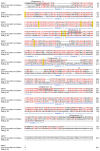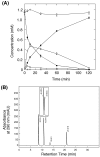Purification, gene cloning, and biochemical characterization of a β-glucosidase capable of hydrolyzing sesaminol triglucoside from Paenibacillus sp. KB0549
- PMID: 23593237
- PMCID: PMC3622683
- DOI: 10.1371/journal.pone.0060538
Purification, gene cloning, and biochemical characterization of a β-glucosidase capable of hydrolyzing sesaminol triglucoside from Paenibacillus sp. KB0549
Abstract
The triglucoside of sesaminol, i.e., 2,6-O-di(β-D-glucopyranosyl)-β-D- glucopyranosylsesaminol (STG), occurs abundantly in sesame seeds and sesame oil cake and serves as an inexpensive source for the industrial production of sesaminol, an anti-oxidant that displays a number of bioactivities beneficial to human health. However, STG has been shown to be highly resistant to the action of β-glucosidases, in part due to its branched-chain glycon structure, and these circumstances hampered the efficient utilization of STG. We found that a strain (KB0549) of the genus Paenibacillus produced a novel enzyme capable of efficiently hydrolyzing STG. This enzyme, termed PSTG, was a tetrameric protein consisting of identical subunits with an approximate molecular mass of 80 kDa. The PSTG gene was cloned on the basis of the partial amino acid sequences of the purified enzyme. Sequence comparison showed that the enzyme belonged to the glycoside hydrolase family 3, with significant similarities to the Paenibacillus glucocerebrosidase (63% identity) and to Bgl3B of Thermotoga neapolitana (37% identity). The recombinant enzyme (rPSTG) was highly specific for β-glucosidic linkage, and k cat and k cat/K m values for the rPSTG-catalyzed hydrolysis of p-nitrophenyl-β-glucopyraniside at 37°C and pH 6.5 were 44 s(-1) and 426 s(-1) mM(-1), respectively. The specificity analyses also revealed that the enzyme acted more efficiently on sophorose than on cellobiose and gentiobiose. Thus, rPSTG is the first example of a β-glucosidase with higher reactivity for β-1,2-glucosidic linkage than for β-1,4- and β-1,6-glucosidic linkages, as far as could be ascertained. This unique specificity is, at least in part, responsible for the enzyme's ability to efficiently decompose STG.
Conflict of interest statement
Figures








Similar articles
-
Identification and characterization of a novel bacterial β-glucosidase that is highly specific for the β-1,2-glucosidic linkage of sesaminol triglucoside.Biosci Biotechnol Biochem. 2018 Sep;82(9):1518-1521. doi: 10.1080/09168451.2018.1476123. Epub 2018 May 26. Biosci Biotechnol Biochem. 2018. PMID: 29804519
-
Structural insights into a bacterial β-glucosidase capable of degrading sesaminol triglucoside to produce sesaminol: toward the understanding of the aglycone recognition mechanism by the C-terminal lid domain.J Biochem. 2023 Sep 29;174(4):335-344. doi: 10.1093/jb/mvad048. J Biochem. 2023. PMID: 37384427
-
Glycoside-specific glycosyltransferases catalyze regio-selective sequential glucosylations for a sesame lignan, sesaminol triglucoside.Plant J. 2020 Mar;101(5):1221-1233. doi: 10.1111/tpj.14586. Epub 2019 Dec 3. Plant J. 2020. PMID: 31654577
-
Characterization of an unusual cold-active beta-glucosidase belonging to family 3 of the glycoside hydrolases from the psychrophilic isolate Paenibacillus sp. strain C7.Appl Environ Microbiol. 2005 Aug;71(8):4225-32. doi: 10.1128/AEM.71.8.4225-4232.2005. Appl Environ Microbiol. 2005. PMID: 16085807 Free PMC article.
-
Commentary on 'Structural insights into a bacterial β-glucosidase capable of degrading sesaminol triglucoside to produce sesaminol: towards the understanding of the aglycone recognition mechanism by the C-terminal lid domain'.J Biochem. 2025 Mar 4;177(3):199-202. doi: 10.1093/jb/mvae094. J Biochem. 2025. PMID: 39745830
Cited by
-
Lignans of Sesame (Sesamum indicum L.): A Comprehensive Review.Molecules. 2021 Feb 7;26(4):883. doi: 10.3390/molecules26040883. Molecules. 2021. PMID: 33562414 Free PMC article. Review.
-
Biochemical and in silico structural properties of a thermo-acid stable β-glucosidase from Beauveria bassiana.Heliyon. 2024 Mar 24;10(7):e28667. doi: 10.1016/j.heliyon.2024.e28667. eCollection 2024 Apr 15. Heliyon. 2024. PMID: 38571589 Free PMC article.
-
Sesaminol prevents Parkinson's disease by activating the Nrf2-ARE signaling pathway.Heliyon. 2020 Nov 2;6(11):e05342. doi: 10.1016/j.heliyon.2020.e05342. eCollection 2020 Nov. Heliyon. 2020. PMID: 33163674 Free PMC article.
-
Iodine values, peroxide values and acid values of Bohai algae oil compared with other oils during the cooking.Heliyon. 2023 Apr 8;9(4):e15088. doi: 10.1016/j.heliyon.2023.e15088. eCollection 2023 Apr. Heliyon. 2023. PMID: 37128346 Free PMC article.
-
Sesame Seeds: A Nutrient-Rich Superfood.Foods. 2024 Apr 10;13(8):1153. doi: 10.3390/foods13081153. Foods. 2024. PMID: 38672826 Free PMC article. Review.
References
-
- Fukuda Y, Nagata M, Osawa T, Namiki M (1986) Contribution of lignan analogs to antioxidative activity of refined unroasted sesame seed oil. Journal of the American Oil Chemists’ Society 63: 1027–1031.
-
- Kumazawa S, Koike M, Usui Y, Nakayama T, Fukuda Y (2003) Isolation of sesaminols as antioxidative components from roasted sesame seed oil. Journal of Oleo Science 52: 303–307.
-
- Kang MH, Katsuzaki H, Osawa T (1998) Inhibition of 2,2′-azobis(2,4-dimethylvaleronitrile)-induced lipid peroxidation by sesaminols. Lipids 33: 1031–1036. - PubMed
-
- Kang MH, Naito M, Sakai K, Uchida K, Osawa T (2000) Mode of action of sesame lignans in protecting low-density lipoprotein against oxidative damage in vitro . Life Sciences 66: 161–171. - PubMed
-
- Miyahara Y, Hibasami H, Katsuzaki H, Imai K, Osawa T, et al. (2001) Sesaminol from sesame seed induces apoptosis in human lymphoid leukemia Molt 4B cells. International Journal of Molecular Medicine 7: 485–488. - PubMed
Publication types
MeSH terms
Substances
LinkOut - more resources
Full Text Sources
Other Literature Sources
Molecular Biology Databases
Miscellaneous

